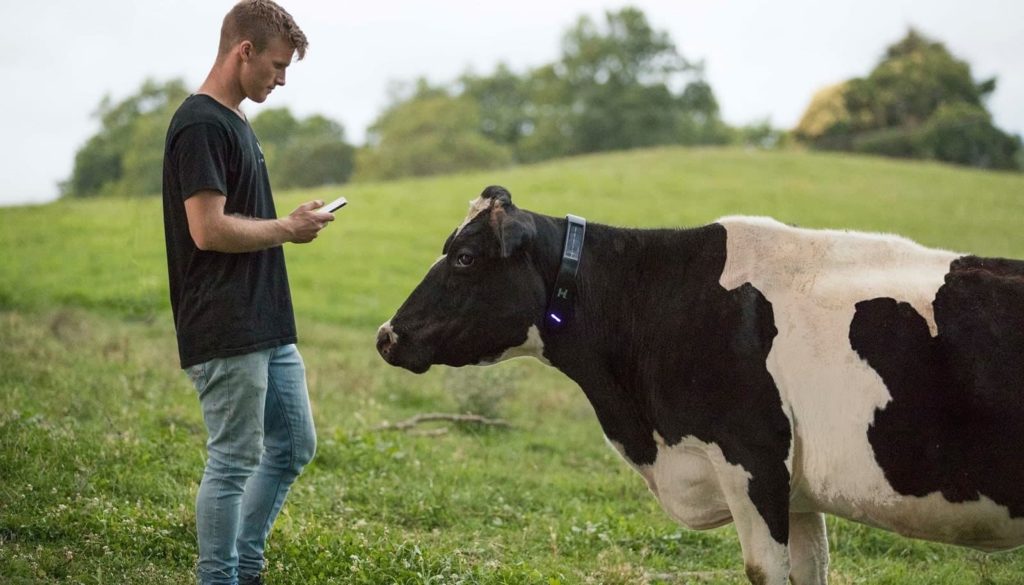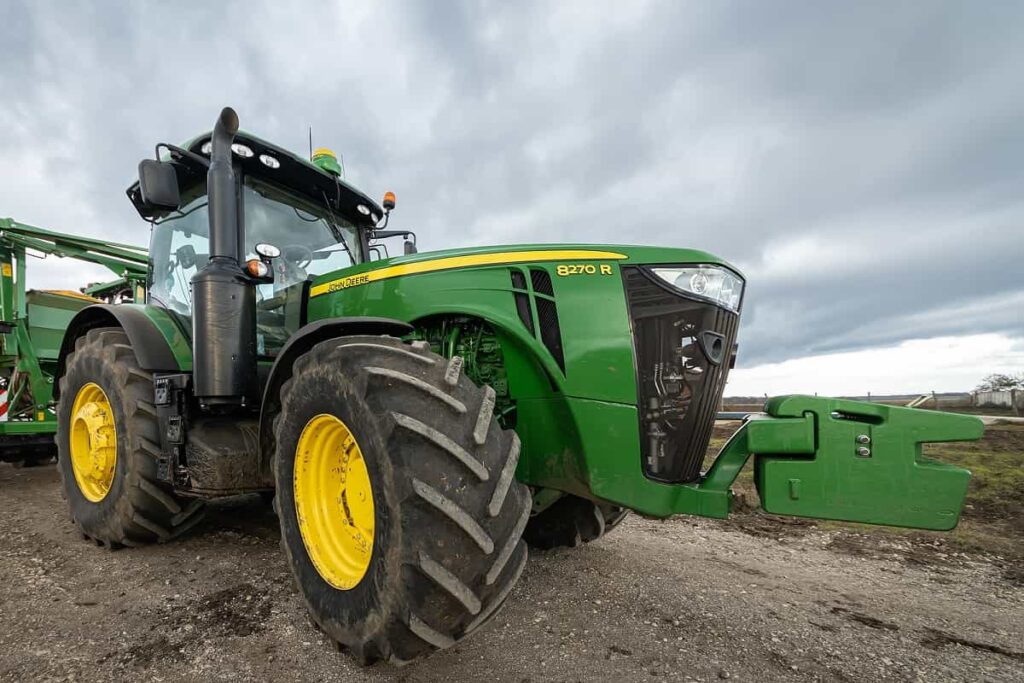Halter Uses AI to Guide and Monitor Herds of Cows
Table of contents

Cattle rustling is back, says an article by National Geographic, and it’s become a lucrative side hustle for meth heads in the State of Oklahoma. Desperate junkies have figured out that loading up a few cows in the middle of the night and selling them hours later for thousands of dollars at an auction is a lot easier than stripping copper out of abandoned homes. Since many cattle ranchers have such large herds, they’re only able to detect missing cows after days have passed. Sure, it’s just a few cows, but with margins tight already these ranchers are feeling it in in their pocketbooks.
Even with the resurgence in cattle rustling, humans have come a long way since the days of cowboys tending small herds of cattle to the present day where nearly 1 billion cows grace the surface of our planet. While the cow population has increased dramatically alongside human population, the labor needed to manage these bovines has plummeted. We’re now able to devote all that free time to study interesting topics such as “The Psychology of Cows,” an academic paper published by some people with lots of time on their hands. Throughout the paper, it talks a lot about how cows exhibit a reasonable level of intelligence and are fairly emotional creatures. Consequently, developing technical solutions for them can be difficult as the cows will always tend towards the behavior that suits them best. One New Zealand startup called Halter thinks that a solar-powered cattle collar is the way forward.
Solar-Powered Cattle Collars


The coolest part? The device uses sound and vibrations to get the cows to move as if they’re being remotely controlled.
One of their investor demos involved a herd of cows standing in a field at 4 AM in the morning on Skype while a would-be investor picked one out of the lot. Halter then used their device to separate the cow from the herd. It’s something farmers call “drafting.” Just imagine having a collar that tells you when a cow is in heat and then automatically guides the cow into a barn so that it can be artificially inseminated. What about saying goodbye to fences? You can with Halter, as it allows you to set up invisible boundaries around cows. This is particularly useful for farmers who sometimes need to do “break fencing” which involves creating temporary fences to make sure cows feed from the most optimal spaces. Below, you can see where a virtual break fence has been set up and all the cows are staying on one side of it.

Getting one or more cows to go anywhere you need them to using an app is remarkable, but it’s just one feature. For every single cow, the farmer can monitor emotions, behavior, and health – such as when a cow is in heat or calving – all from a smartphone, 24/7.
The solar-powered collars use LoRa to communicate, and the amount of big data they’re generating is perfectly suited for artificial intelligence algorithms to then start optimizing things and connecting the dots. Everyone we spoke to in the New Zealand agtech space is excited about Halter. The idea sounds exceptionally good on paper – 3-4 hours a day time savings for a farmer – but it’s impossible to quantify the value proposition without understanding a bit more about a farmer’s pain points. So, we visited a dairy farm.
Cows that Queue
Let’s say you decide to leave your unfulfilling middle-management career in the corporate world and pursue the idyllic life of a dairy farmer. (You’ll find some similarities between the two occupations. In both cases, you’re tasked with getting moderately-intelligent emotional creatures to do things for you while trying to avoid killing them.) In order to better understand what it takes to manage cows, we traveled to the Lincoln University Dairy Farm outside of Christchurch, New Zealand to visit with Demonstration Manager Clare Buchanan who showed us around the commercial farm which operates in the top 2% on profitability by employing some of the industry’s best farmers and utilizing technical input from seven different organizations.

Dairy operations are interesting places to visit if you get a chance. We were there when all the cows were queuing up to get milked. That’s right, the cows queue in an orderly fashion that would rival any of Hong Kong’s recent voting queues. When you approach the cows, some will walk up and stare curiously while others will get upset and scamper away. (That’s a bad thing on a dairy farm because cows that get stressed produce less milk.) Each cow eventually makes its way through the queue up into a small cage where a human attaches the milking device on the cow. Once the milking completes, the cows mosey off and all walk – again, in an orderly queue – out to the pasture to eat grass. They love eating grass so much that they behave in a manner that lets them get back to eating grass as soon as possible. The cows know the milking has to happen, and they want to get it over with ASAP.
Now, a few things came to mind immediately. Firstly, this is a perfect place for Mainland Chinese tourists to visit and learn how queuing systems work. Secondly, if these cows are trained so well, why do we need collars to make them move about? We posed that question to Peter Hancox, Farm Manager at Lincoln University Dairy Farm for the past 15 years, and someone who has been dealing with cows his entire life.
Gimmick or Game Changer?
Being the skeptics that we are, we initially asked Mr. Hancox if he thought Halter’s solution was a bit long on features and short on practicality. He emphatically disagreed, and you could see his excitement when we started to talk about some farmers he knew that were testing the product. The capabilities are nothing short of game-changing.

He had nothing but favorable things to say about the feature set, so we honed in on any concerns he might have. The first was the form factor which he thought might be too bulky. While that’s certainly not a show-stopper, his other concern could very well be. Halter plans to sell their device on a subscription basis – “cow-management-as a-service.” The price point is critically important to spur adoption, especially in the face of a competing solution Mr. Hancox currently uses that offers some of Halter’s functionality.
Competing Against Merck
It all starts with an Israeli startup called SCR which developed its first collar tags for cows back in 1998, and then began mass-marketing them in 2006. That’s according to a 2014 article by the Times of Israel which talks about how SCR was then acquired by a U.S. firm called Allflex whose origins go back to back to 1955 when they were founded in Palmerston North, New Zealand. Today, Allflex belongs to holding company Affliq which was acquired earlier this year by Merck (MRK), a $221 billion pharmaceutical company, that said this positions them as “a global leader in animal health digital tracking, traceability and monitoring technology.” At the moment, that might be a good thing for Halter.
Acquisitions typically don’t bode well for larger companies, and most of the time all those “2 + 2 = 5” synergies aren’t realized. A study by KPMG on blue-chip M&A activities over a two-year time frame showed that, “only 17% of deals had added value to the combined company, 30% produced no discernible difference, and as many as 53% actually destroyed value.” As a startup, Halter can certainly be a lot more nimble. They can also learn from what others are saying about the competition.
Mr. Hancox bemoaned not being able to find experienced farmhands who would stick around long enough to learn things like how to tell when a cow is in heat. Because of these labor constraints, his team has been trialing SCR collars for a few seasons, though having them on only a portion of the herd hasn’t been as beneficial as hoped. They are in the process of assessing the different options out there and intend to get monitoring devises on the entire herd in the next season.

The batteries have a shelf life of about five years (the new ones seen above, seven years) which means he’ll have to plan to buy replacements. Not having to buy Halter’s collars is a perk he said, but it all comes down to how much Halter plans to charge for their “as a service” business model.
Since Halter is well aware of all the competing solutions on the market, the whole thing is playing out like a Harvard Business School case study. How will the competition react to the added functionality Halter plans to offer? Will they sacrifice margin to compete on price? Maybe they’re not even going to compete that much. With one billion cows scattered around the world, there’s enough total addressable market for everyone. Merck also has deep pockets – $8.8 billion in cash as of year-end 2018 – so they can just kick the tires until there’s enough traction, and then boom, there’s your exit. In the meantime, Merck will be focused on realizing synergies they need to justify their acquisition and appease shareholders.
Conclusion
Lately, venture capitalists have been spending billions of dollars figuring out how to turn plant products into meat – something that cows have been doing for centuries. Trying to guilt people into not eating beef might work well in places like ‘Murica, but we still need to consider the other 95.65% of the world’s population that might not be able to afford over-priced pea protein patties nor want to eat them. (That being said, people in India have been substituting beef with vegetables for centuries now.) Cows aren’t going anywhere, and companies like Halter are making the process of tending to them more efficient, which means less resources are needed to raise cows – not just human resources but natural resources. The question is, can Halter come in at a price point that will make it a no-brainer for ranchers to adopt?
Sign up to our newsletter to get more of our great research delivered straight to your inbox!
Nanalyze Weekly includes useful insights written by our team of underpaid MBAs, research on new disruptive technology stocks flying under the radar, and summaries of our recent research. Always 100% free.














